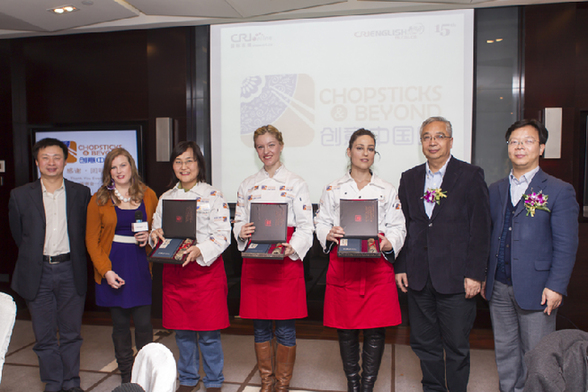Chopsticks and Beyond thank you dinner
 0 Comment(s)
0 Comment(s) Print
Print E-mail CRI, November 12, 2013
E-mail CRI, November 12, 2013
It's been half a year since the first official Chopsticks and Beyond show back in June this year. Since then CRI has produced four episodes, each one challenging foreign contestants to create a fusion dish combining tastes from their country and China. Amateur cooks from across the world took part with each show focusing on one of four Chinese cooking styles, namely Shandong, Huaiyang (both from eastern China), Cantonese (southern China), and Sichuan (western China).
 |
|
The three contestants, (L-R) Sopit Wangvivatana from Thailand, Ana Perez from Spain and Elyse Ribbons from the USA show off their prizes at the end of the contest. |
Chopsticks and Beyond has been one of the most ambitious projects ever laid on by CRIENGLISH.com's web team. And after such a successful first season, the team recently found time to sit back, relax and give a pat on the back to all that contributed. Naturally this was done in the spirit of the show, which included food of the highest standard -- at the Hilton Hotel in Wangfujing, no less -- and a small cooking challenge for three foreign guests. They were: Sopit Wangviviatana from Thailand that works for CRI's Thai language service; Ana Perez, a Chinese language student from Spain; and Elyse Ribbons from the US who runs a theatre company in Beijing.
The menu for the afternoon was Beijing's most popular dish, roast duck. Normally this is served with a thick black sweet sauce. Prior to this event, however, the three contestants were asked to make their own condiment, mixing elements from their homeland and China.
Saucy
"I'm very into Mexican food," says Elyse in her white chef's outfit just before the meal, "so today when we had to prepare a sauce for Peking duck and we needed something from our home, I thought, you know what would be perfect is mole."
Elyse explains that Mole [pronounced mo-lay] is a Mexican sauce made from around 26 ingredients -- including chocolate -- all ground up together producing a thick savoury sauce that can accompany fish, meat or fowl.
"I definitely wanted to make something with a Latin flare and a little bit of spice. You know kaoya [Peking duck] is a very fatty kind of meat and there's a little hint of sweetness and I thought a salsa might go well, but actually it didn't, and I tried a pineapple salsa and that didn't go well either. And I thought it needs a thicker sauce that has a stronger flavour to combat the kaoya so that they can combine together and create something beautiful and that's where the mole came in."
Elyse is so confident in her creation she's hoping it will be added to the menu of her favourite Mexican restaurant in Beijing. But she was up against stiff competition from the two other budding chefs. Ana from Spain describes her creation:
"I think this is a very special sauce, I only used one Spanish ingredient, which is olive oil, and mixed it with sesame paste, with lemon and then I added some gherkins and some other sesame seeds - mixed together and the taste is a little bit sour."
Ana claims the process of making the sauce was not hard, "but because the sesame paste is a little bit dense you have to mix it for a long time to make it more liquid. This was the most difficult part. The rest is just getting the other ingredients and mixing in the right amount."
Sopit from Thailand stuck to a more traditional recipe, producing a thick black sauce that looks like the traditional Chinese soy-based sauce that is added to Peking duck. But the two main ingredients she added to give a flavour of her country were the spice tamarind, for a sour flavour; and lemon grass, commonly found in the popular Thai dish tomyam soup, to add a fresh aroma.
"I prepared [the lemon grass] by boiling it in water. I used the water to make the tamarind juice, and also mixed it with sugar to make the candy caramel, because the taste of my sauce is a mix of sweet, salty and sour."
Sopit said she was temped to make the sauce more spicy for the Thai palate. But on second thoughts she decided to offer strips of chili on the side so guests could add their own according to taste.
"I also prepared some other ingredients by frying a little bit of garlic with other herbs in order to make it smell better and put the soy beans and lemon grass together to marinade for two hours," she said.
Finally the time came to enter the dining room where forty guests were waiting at four large round tables decked in white table cloth, white plates, flowers and green bottles of mineral water imported from New Zealand. After a few opening words from hosts, CRI's Lucy and Amy, the event got off to a flying start as four bronze roast ducks were wheeled into the room.






Go to Forum >>0 Comment(s)